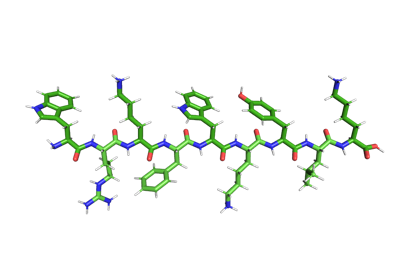biotite.structure.superimpose¶
- biotite.structure.superimpose(fixed, mobile, atom_mask=None)[source]¶
Superimpose structures onto a fixed structure.
The superimposition is performed using the Kabsch algorithm 12, so that the RMSD between the superimposed and the fixed structure is minimized.
- Parameters
- fixedAtomArray, shape(n,) or AtomArrayStack, shape(m,n) or ndarray, shape(n,), dtype=float or ndarray, shape(m,n), dtype=float
The fixed structure. Alternatively coordinates can be given.
- mobile: AtomArray, shape(n,) or AtomArrayStack, shape(m,n) or ndarray, shape(n,), dtype=float or ndarray, shape(m,n), dtype=float
The structure(s) which is/are superimposed on the fixed structure. Each atom at index i in mobile must correspond the atom at index i in fixed to obtain correct results. Alternatively coordinates can be given.
- atom_mask: ndarray, dtype=bool, optional
If given, only the atoms covered by this boolean mask will be considered for superimposition. This means that the algorithm will minimize the RMSD based on the covered atoms instead of all atoms. The returned superimposed structure will contain all atoms of the input structure, regardless of this parameter.
- Returns
- fittedAtomArray or AtomArrayStack or ndarray, shape(n,), dtype=float or ndarray, shape(m,n), dtype=float
A copy of the mobile structure(s), superimposed on the fixed structure. Only coordinates are returned, if coordinates were given in mobile.
- transformationAffineTransformation
This object contains the affine transformation(s) that were applied on mobile.
AffineTransformation.apply()can be used to transform another AtomArray in the same way.
Notes
The transformation can come in handy, in case you want to superimpose two structures with different amount of atoms. Often the two structures need to be filtered in order to obtain the same size and annotation arrays. After superimposition the transformation can be applied on the original structure using
AffineTransformation.apply().References
- 1
W. Kabsch, “A solution for the best rotation to relate two sets of vectors,” Acta Crystallographica Section A: Crystal Physics, Diffraction, Theoretical and General Crystallography, vol. 32, pp. 922–923, September 1976. doi: 10.1107/S0567739476001873
- 2
W. Kabsch, “A discussion of the solution for the best rotation to relate two sets of vectors,” Acta Crystallographica Section A: Crystal Physics, Diffraction, Theoretical and General Crystallography, vol. 34, pp. 827–828, September 1978. doi: 10.1107/S0567739478001680
Examples
At first two models of a structure are taken and one of them is randomly rotated/translated. Consequently the RMSD is quite large:
>>> array1 = atom_array_stack[0] >>> array2 = atom_array_stack[1] >>> array2 = translate(array2, [1,2,3]) >>> array2 = rotate(array2, [1,2,3]) >>> print("{:.3f}".format(rmsd(array1, array2))) 11.260
RMSD decreases after superimposition of only CA atoms:
>>> array2_fit, transformation = superimpose( ... array1, array2, atom_mask=(array2.atom_name == "CA") ... ) >>> print("{:.3f}".format(rmsd(array1, array2_fit))) 1.961
RMSD is even lower when all atoms are considered in the superimposition:
>>> array2_fit, transformation = superimpose(array1, array2) >>> print("{:.3f}".format(rmsd(array1, array2_fit))) 1.928





